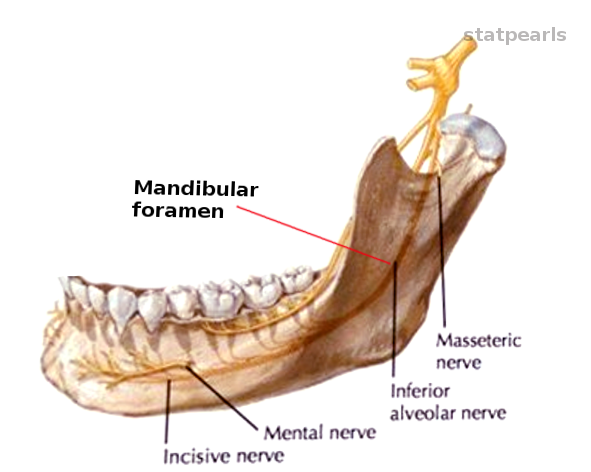[2]
Al-Shayyab MH, Qabba'ah K, Alsoleihat F, Baqain ZH. Age and gender variations in the cone-beam computed tomographic location of mandibular canal: Implications for mandibular sagittal split osteotomy. Medicina oral, patologia oral y cirugia bucal. 2019 Jul 1:24(4):e545-e554. doi: 10.4317/medoral.22969. Epub 2019 Jul 1
[PubMed PMID: 31232390]
[3]
Friedrich RE, Matschke J, Wilczak W. Unilaterally Enlarged Mandibular Foramina and Canal Associated With Hyperplastic Lymphatic Tissue of Inferior Alveolar Nerve: Case Report and Short Literature Survey. Anticancer research. 2019 Aug:39(8):3991-4002. doi: 10.21873/anticanres.13554. Epub
[PubMed PMID: 31366480]
Level 3 (low-level) evidence
[4]
Hwang TJ, Hsu SC, Huang QF, Guo MK. [Age changes in location of mandibular foramen]. Zhonghua ya yi xue hui za zhi. 1990 Sep:9(3):98-103
[PubMed PMID: 2135997]
[5]
Predoiu M, Rusu MC, Chiriţă AL. A rare anatomic variation: Triple mental foramina. Morphologie : bulletin de l'Association des anatomistes. 2019 Jun:103(341 Pt 2):110-115. doi: 10.1016/j.morpho.2019.04.004. Epub 2019 May 15
[PubMed PMID: 31103465]
[6]
Lam M, Koong C, Kruger E, Tennant M. Prevalence of Accessory Mental Foramina: A Study of 4,000 CBCT Scans. Clinical anatomy (New York, N.Y.). 2019 Nov:32(8):1048-1052. doi: 10.1002/ca.23434. Epub 2019 Jul 25
[PubMed PMID: 31301240]
[7]
Thangavelu K, Kannan R, Kumar NS, Rethish E, Sabitha S, Sayeeganesh N. Significance of localization of mandibular foramen in an inferior alveolar nerve block. Journal of natural science, biology, and medicine. 2012 Jul:3(2):156-60. doi: 10.4103/0976-9668.101896. Epub
[PubMed PMID: 23225978]
[8]
Subramanian B, Anthony SN, Mubbunu L, Hachombwa C, Mlawa MS, Majambo MM, Sasi RM. Anthropometrics Analysis of Mental Foramen and Accessory Mental Foramen in Zambian Adult Human Mandibles. TheScientificWorldJournal. 2019:2019():9093474. doi: 10.1155/2019/9093474. Epub 2019 Jul 16
[PubMed PMID: 31379470]
[9]
Kalabalik F, Aytuğar E. Localization of the Mandibular Canal in a Turkish Population: a Retrospective Cone-Beam Computed Tomography Study. Journal of oral & maxillofacial research. 2019 Apr-Jun:10(2):e2. doi: 10.5037/jomr.2019.10202. Epub 2019 Jun 30
[PubMed PMID: 31404191]
Level 2 (mid-level) evidence
[10]
Costa ED, Peyneau PD, Visconti MA, Devito KL, Ambrosano GMB, Verner FS. Double mandibular canal and triple mental foramina: detection of multiple anatomical variations in a single patient. General dentistry. 2019 Sep-Oct:67(5):46-49
[PubMed PMID: 31454322]
[11]
Qi W, Lei J, Liu YN, Li JN, Pan J, Yu GY. Evaluating the risk of post-extraction inferior alveolar nerve injury through the relative position of the lower third molar root and inferior alveolar canal. International journal of oral and maxillofacial surgery. 2019 Dec:48(12):1577-1583. doi: 10.1016/j.ijom.2019.07.008. Epub 2019 Jul 28
[PubMed PMID: 31362896]
Level 2 (mid-level) evidence
[12]
Kang F, Sah MK, Fei G. Determining the risk relationship associated with inferior alveolar nerve injury following removal of mandibular third molar teeth: A systematic review. Journal of stomatology, oral and maxillofacial surgery. 2020 Feb:121(1):63-69. doi: 10.1016/j.jormas.2019.06.010. Epub 2019 Aug 30
[PubMed PMID: 31476533]
Level 1 (high-level) evidence
[13]
Shen H, Wang S, Zhi Y, Si J, Shi J. Effects of inferior alveolar nerve rupture on bone remodeling of the mandible: A preliminary study. Medicine. 2019 Aug:98(35):e16897. doi: 10.1097/MD.0000000000016897. Epub
[PubMed PMID: 31464921]
[14]
Kommineni M, Kuchimanchi PK, Koneru G, Sanikommu S. A Simplified Single-Penetration Technique of IANB (MK Technique) for Mandibular Anesthesia. Journal of maxillofacial and oral surgery. 2019 Sep:18(3):459-465. doi: 10.1007/s12663-018-1169-1. Epub 2018 Oct 29
[PubMed PMID: 31371891]
[15]
Kojima Y, Murouchi T, Akiba M, Oka T. Ultrasound-guided inferior alveolar nerve block for postoperative analgesia after mandibular sequestrectomy: A single-center retrospective study. Journal of clinical anesthesia. 2020 Mar:60():39-40. doi: 10.1016/j.jclinane.2019.08.026. Epub 2019 Aug 20
[PubMed PMID: 31442855]
Level 2 (mid-level) evidence
[16]
Soares AL, Simon S, Gebrim LH, Nazário ACP, Lazaretti-Castro M. Prevalence and risk factors of medication-related osteonecrosis of the jaw in osteoporotic and breast cancer patients: a cross-sectional study. Supportive care in cancer : official journal of the Multinational Association of Supportive Care in Cancer. 2020 May:28(5):2265-2271. doi: 10.1007/s00520-019-05044-0. Epub 2019 Aug 29
[PubMed PMID: 31468192]
Level 2 (mid-level) evidence
[17]
Brijs K, Miclotte I, Vermeire S, Darche V, Politis C. Osteonecrosis of the jaw in patients with inflammatory bowel disease treated with tumour necrosis factor alpha inhibitors. International journal of oral and maxillofacial surgery. 2020 Mar:49(3):317-324. doi: 10.1016/j.ijom.2019.08.007. Epub 2019 Aug 27
[PubMed PMID: 31466830]
[18]
Fujita M, Hirokawa Y, Naito K, Tagashira N, Yajin K, Wada T. Recurrent lower gingival squamous cell carcinoma spreading along the pathway of the inferior alveolar nerve. Oral surgery, oral medicine, oral pathology, oral radiology, and endodontics. 1995 Sep:80(3):369-75
[PubMed PMID: 7489283]
[19]
Razak A, Goh BS, Rajaran JR, Nazimi AJ. Numb chin syndrome: an ominous sign of mandibular metastasis. BMJ case reports. 2018 May 14:2018():. pii: bcr-2017-223586. doi: 10.1136/bcr-2017-223586. Epub 2018 May 14
[PubMed PMID: 29764822]
Level 3 (low-level) evidence

